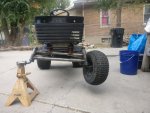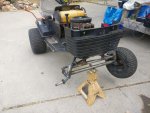sgkent
Lawn Addict
- Joined
- Sep 27, 2017
- Threads
- 30
- Messages
- 1,679
Yeah those #s are correct. I will be blending a very high octane fuel. I'll start with premium and cut it with 115 leaded as I dial in the timing to keep preignition/detonation in check to figure out my target octane. I may be up in the night, but I think I can control the problem with that approach. The flow through the intake and exhaust tracts looks like a joke on this motor, so while it doesn't sound like she's the best candidate for high HP, I have to assume that with my experience in aerodynamics I can at least create more laminar flow, without making them too big, and squeeze what is possible out of this thing. Because I can't find any solid info on compression ratio, I am just going to shoot for 9-9.5:1, that seems reasonable in my mind. If anyone disagrees on any of this, I would love to hear from someone with more B&S experience than myself. I'm not too proud to accept input from anyone, rather I would much appreciate it.
View attachment 40665View attachment 40666
Does working as a automotive engine machinist for a shop that built winning racers and engines for Al Unser Jr qualify for experience understanding racing motors? Winning many SCCA events and a championship in FP qualify?
"I have to assume that with my experience in aerodynamics I can at least create more laminar flow" - I am puzzled. One does not want a laminar flow because that denies you use of the rest of the manifold cross section. Be sure to keep the inside of the manifolds sand paper rough because the turbulence will pull the laminar flows back to use the whole manifold cross section.
3500 RPM is 3500 RPM. 3500 RPM x the gearbox (belt hubs, wheels etc) is X number of MPH whether in a Ferrari or on a mower. A mower doing 30 mph and a Ferrari traveling 30 mph are neck in neck and remain that way indefinitely. In order for the Ferrari to pass the mower it has to move faster which requires the engine run a higher RPM. The way you beat someone is you (1) get your engine to a higher RPM so your top HP is greater given the same gear ratios (2) lighten your vehicle so that there is less mass to push to that top speed, you'll get there first (3) increase torque so your vehicle goes faster between RPM's. By back cutting the valves, improving the intake and exhaust you can increase the amount of air (to combine with fuel) available. To use it the engine has to either be a larger displacement or be able to reach a higher RPM quicker. What you are doing will help the engine speed up faster but not so much I would bank that is a winning strategy. Personally I'd start by lowering the weight of the vehicle combined with what you are doing, and the largest displacement that can be used with that connecting rod, crank, hub and keys. I will add this - if you are able to raise the power band with what you are doing, play with the drive hub sizes to see if you can get to speed faster. Anything that lets you get to your max speed faster will give you time gains over your competition. I am guessing those mowers don't do anything but compression brake so raising the compression should assist in braking if the course has slower sections on it. Be sure to take your practice laps.



